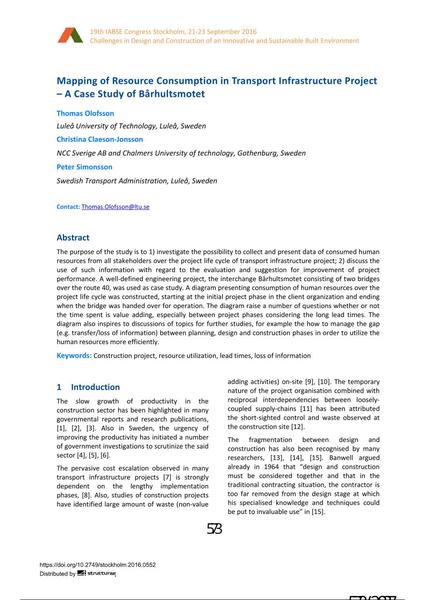Mapping of Resource Consumption in Transport Infrastructure Project

|
|
|||||||||||
Bibliografische Angaben
| Autor(en): |
Thomas Olofsson
(Luleå University of Technology, Luleå, Sweden)
Christina Claeson-Jonsson (NCC Sverige AB and Chalmers University of technology, Gothenburg, Sweden) Peter Simonsson (Swedish Transport Administration, Luleå, Sweden) |
||||
|---|---|---|---|---|---|
| Medium: | Tagungsbeitrag | ||||
| Sprache(n): | Englisch | ||||
| Tagung: | IABSE Congress: Challenges in Design and Construction of an Innovative and Sustainable Built Environment, Stockholm, Sweden, 21-23 September 2016 | ||||
| Veröffentlicht in: | IABSE Congress Stockholm, 2016 | ||||
|
|||||
| Seite(n): | 573-579 | ||||
| Anzahl der Seiten (im PDF): | 7 | ||||
| Jahr: | 2016 | ||||
| DOI: | 10.2749/stockholm.2016.0552 | ||||
| Abstrakt: |
The purpose of the study is to 1) investigate the possibility to collect and present data of consumed human resources from all stakeholders over the project life cycle of transport infrastructure project; 2) discuss the use of such information with regard to the evaluation and suggestion for improvement of project performance. A well-defined engineering project, the interchange Bårhultsmotet consisting of two bridges over the route 40, was used as case study. A diagram presenting consumption of human resources over the project life cycle was constructed, starting at the initial project phase in the client organization and ending when the bridge was handed over for operation. The diagram raise a number of questions whether or not the time spent is value adding, especially between project phases considering the long lead times. The diagram also inspires to discussions of topics for further studies, for example the how to manage the gap (e.g. transfer/loss of information) between planning, design and construction phases in order to utilize the human resources more efficiently. |
||||
